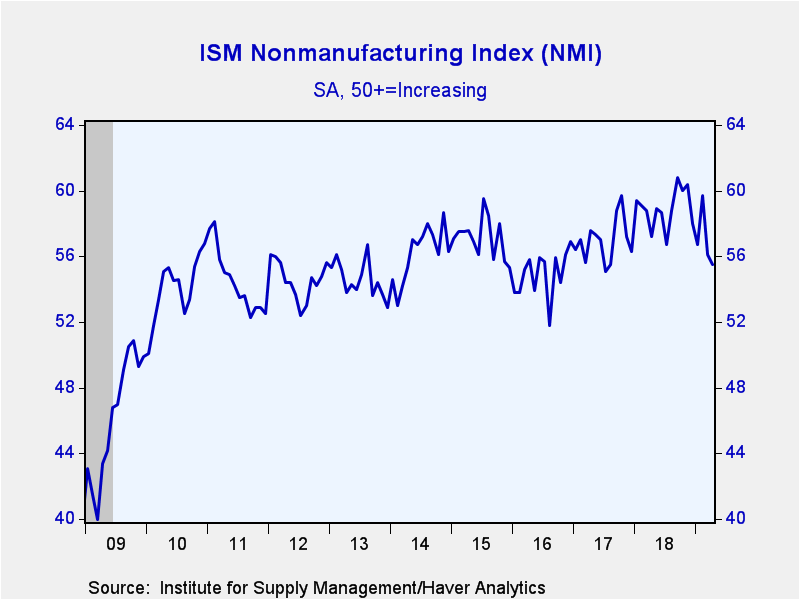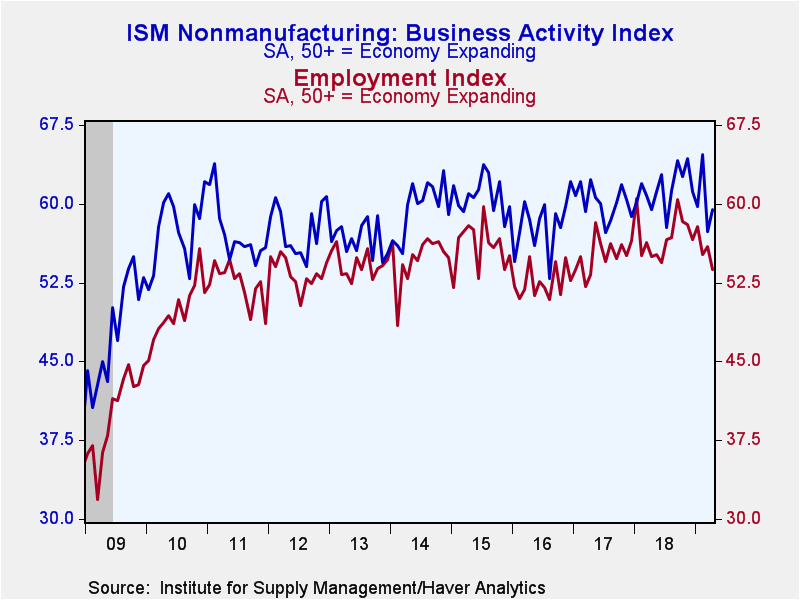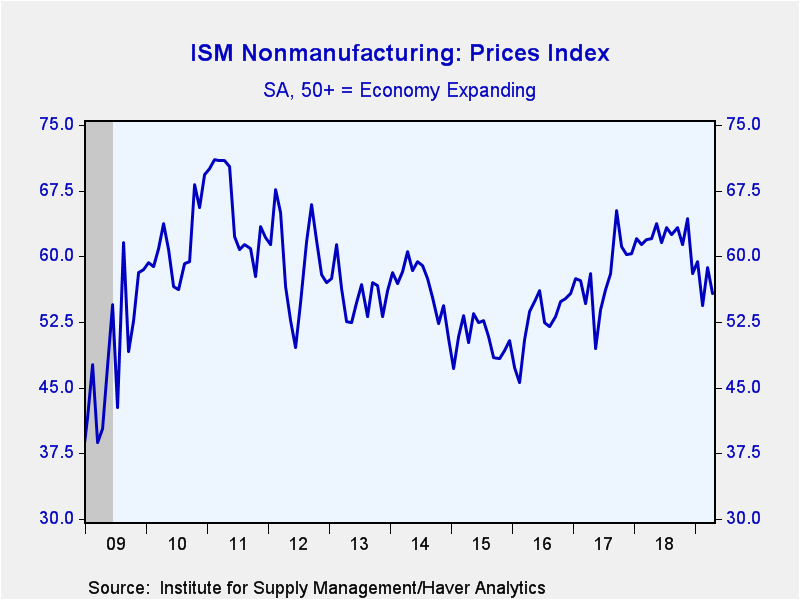 Global| May 03 2019
Global| May 03 2019U.S. ISM Nonmanufacturing Index Unexpectedly Slipped in April
by:Sandy Batten
|in:Economy in Brief
Summary
The Composite Index of Nonmanufacturing Sector Activity from the Institute for Supply Management (ISM) slipped to 55.5 in April from 56.1 in March. This was the fourth monthly decline in the past five months but leaves the index still [...]
The Composite Index of Nonmanufacturing Sector Activity from the Institute for Supply Management (ISM) slipped to 55.5 in April from 56.1 in March. This was the fourth monthly decline in the past five months but leaves the index still well above the critical 50 level that separates expansion from contraction. Nonetheless, this is the lowest reading for this index since July 2017 and well below the most recent 12-month average of 58.4. The Action Economics Forecast Survey expected an increase to 57.3.
Haver Analytics constructs a Composite Index using the nonmanufacturing ISM index and the ISM manufacturing measure, which was released on May 1. This composite also slipped in April—to 55.2 from 56.0 in March. This is the lowest reading on this constructed index since October 2016. Over the past 15 years, there has been a 71% correlation between this index and the quarter-on-quarter change in real GDP.
Of the nonmanufacturing index's four components, one rose and three fell in April. The business activity component index (a proxy for output) rose to 59.5 in April from 57.4, but failed to regain the ground it has lost in March. In contrast, the new orders, employment and supplier deliveries component index each fell in April. Orders slipped to 58.1 from 59.0. Employment declined to 53.7 from 55.9, its lowest reading since April 2017. And supplier deliveries decreased to 50.5 from 52.0.
The prices paid index eased to 55.7 from 58.7 and continues on a modest downtrend since late 2018. Twenty percent of firms (NSA) paid higher prices while only four percent of firms paid lower prices in April. Prices paid were unchanged for the remainder.
Among the other detail subindexes, which are not seasonally adjusted, the export order series strengthened m/m in April and has been recovering recently from a steep drop in January (likely related to tariff concerns). The import index jumped up to its highest reading since last September, while the order backlog index slipped to 55.0 from 56.6.
The ISM figures are available in Haver's USECON database, with additional detail in the SURVEYS database. The expectations figure from Action Economics is in the AS1REPNA database.
| ISM Nonmanufacturing Survey (SA) | Apr | Mar | Feb | Apr'18 | 2018 | 2017 | 2016 |
|---|---|---|---|---|---|---|---|
| Composite Diffusion Index | 55.5 | 56.1 | 59.7 | 57.2 | 58.9 | 57.0 | 54.9 |
| Business Activity | 59.5 | 57.4 | 64.7 | 59.5 | 61.5 | 60.2 | 58.0 |
| New Orders | 58.1 | 59.0 | 65.2 | 59.6 | 61.3 | 59.3 | 57.6 |
| Employment | 53.7 | 55.9 | 55.2 | 55.0 | 56.9 | 55.1 | 52.5 |
| Supplier Deliveries (NSA) | 50.5 | 52.0 | 53.5 | 54.5 | 55.8 | 53.2 | 51.5 |
| Prices Index | 55.7 | 58.7 | 54.4 | 62.0 | 62.1 | 57.6 | 52.6 |
Sandy Batten
AuthorMore in Author Profile »Sandy Batten has more than 30 years of experience analyzing industrial economies and financial markets and a wide range of experience across the financial services sector, government, and academia. Before joining Haver Analytics, Sandy was a Vice President and Senior Economist at Citibank; Senior Credit Market Analyst at CDC Investment Management, Managing Director at Bear Stearns, and Executive Director at JPMorgan. In 2008, Sandy was named the most accurate US forecaster by the National Association for Business Economics. He is a member of the New York Forecasters Club, NABE, and the American Economic Association. Prior to his time in the financial services sector, Sandy was a Research Officer at the Federal Reserve Bank of St. Louis, Senior Staff Economist on the President’s Council of Economic Advisors, Deputy Assistant Secretary for Economic Policy at the US Treasury, and Economist at the International Monetary Fund. Sandy has taught economics at St. Louis University, Denison University, and Muskingun College. He has published numerous peer-reviewed articles in a wide range of academic publications. He has a B.A. in economics from the University of Richmond and a M.A. and Ph.D. in economics from The Ohio State University.










